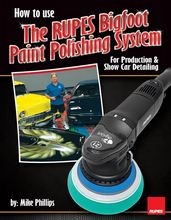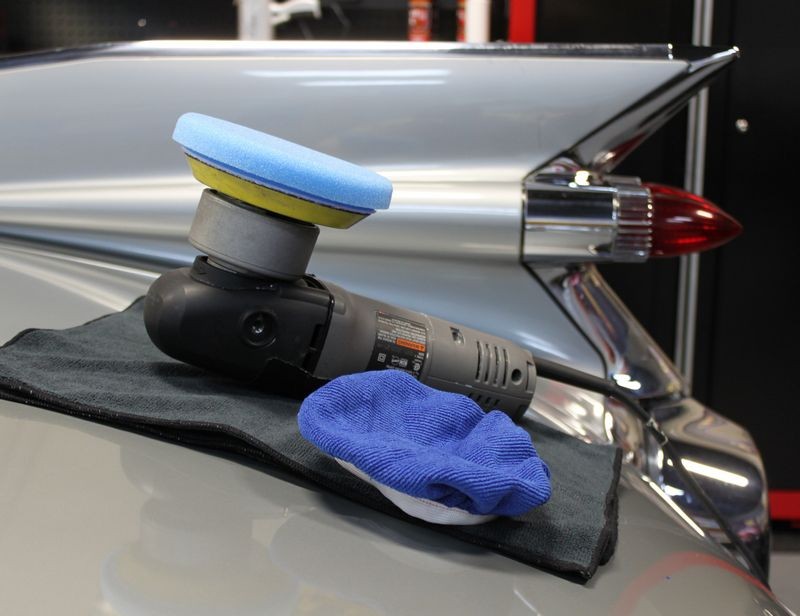How to use a microfiber bonnet to remove dried wax by machine
Indigo on Hydro
If you own a DA Polisher, like a Porter Cable, Meguiar’s or Griot’s Garage DA Polisher, then here’s how you can use your polisher to remove dried wax.
Removing dried wax by machine works best when you apply a thin coat to start with and the best way to apply a thin coat of wax is by machine. Of course if you already own a DA Polisher than you probably already know this and already apply your waxes by machine. So let’s take a look at removing dried wax by machine.
Waxes that dry to a haze
The first thing I want to point out is removing wax works best if you’re using a wax that is supposed to dry to a haze, this is because once it’s grip is loosened from the paint because it’s dry it doesn’t try to stick to the paint. Waxes that dry to a haze also won’t dampen the microfiber bonnet and the nap won’t load up as easily or quickly as will happen when removing a wipe on, wipe off wax.
Wipe On, Wipe Off Waxes
First, if you’re removing a wax that is still wet it won’t take very long for the wetness of the product to dampen the nap of the microfiber bonnet and tend to load up until the nap is coated with wet wax. At this point it will more or less stop removing the wax efficiently until you change to a dry microfiber. So while it can be done, removing wax by machine works best when used to remove waxes that have dried to a haze.
Firm, Dense Pads
The key to removing dried wax using a DA Polisher is a firm pad like a foam cutting pad or a Lambswool pad. My personal preference has always been to use a foam pad because it provides a level of cushion due to the nature of the foam cell wall structure, the Lambswool has no foam cushion, it is simply a soft lambswools skin with a Hook-n-Loop backing glued to the skin side of the Lambswool. The foam cushioning feature also enables the pad to conform to a curves and body lines better than the hard, flat feature provided by the lambswool pad with a microfiber bonnet over it.
Any of these foam pads work well for removing dried wax,
5.5” Lake Country Flat Yellow Cutting Pad
5.5” Lake country Flat Orange Light Cutting Pad
5.5” Lake Country CCS Yellow Cutting Pad
5.5” Lake country CCS Orange Light Cutting Pad
6” Lake Country Purple Kompressor Pad
6” Lake Country Orange Kompressor Pad
Dedicated Pad
Now this is important, when using microfiber bonnets to remove dried wax you only want to use,
- Dry pads
- Clean pads
Dry Pads
If the pad is wet, it will transfer its liquid to the microfiber and get it wet; this will dramatically reduce its ability to remove wax. So don’t try to use a pad that’s either wet with product or wet after being washed clean.
Clean pads
If your pad has been previously used to apply some kind of paint care product and it’s dry, the dried residue in the pores of the foam pad will shake loose and accumulate inside the bonnet. This will contaminate that side of the bonnet making it unusable.
The best thing to do is to dedicate a pad to go with your bonnets and don’t ever use that pad for any machine cleaning or polishing work. If possible, you can mark the back with Sharpie permanent marker.
Reversible Bonnets
Microfiber bonnets are pretty much all reversible so you can use one side till it loads up with dried wax and then remove it, turn it inside out, give it a shake and put back onto your buffing pad and get back to work with the other side. I’ll show you my technique for cleaning your bonnet on the fly and often times you can remove all the wax off an average size car with just one side of bonnet.
Swipe Test
The first thing you want to do is to test the wax to make sure it’s dry and ready to remove and you do this with what’s called the Swipe Test. Once the swipe test shows the wax is ready to remove, you can begin removing the wax by machine.
Removing the Wax
It doesn’t matter much where you start but the normal protocol would be to start where you started when you applied the wax and then follow your path of travel. Another way is to just start at the top and work your way down.
Work Area Size
Basically as far as you can reach and manage comfortably. When removing defects you only want to work a small section at at time. When applying a liquid wax by machine and when removing dried wax by machine you can basically tackle as large an area as you like.
Speed Setting
You need a fast speed setting to remove the wax, I tend to use the 5.0 Speed Setting as it’s not as violent as the 6.0 speed setting but you need to at least be on the 5.0 speed setting.
Downward Pressure
You want to use firm downward pressure when removing the wax. The reason for this is you want the nap of the microfiber slicing into the coating of wax and then breaking it up and this cannot be accomplished with light pressure.
VERY IMPORTANT
Don’t lift the face of the buffing pad off the car at any time when operating the polisher at high speeds, if you do the pad rotation will quickly speed up and chances are very good your buffing pad will fly off the backing plate and land on the ground somewhere where it will become contaminated with dirt and unusable.
A technique for how to move the polisher from panel to panel without having the pad fly off even though you don’t turn the polisher off is to at the same time you lift the pad off the surface, quickly place your clean hand against the pad, this won`t hurt you and will keep the pad from flying off the polisher till you touch it down again on a new panel, for example going from the roof to the hood, or from the hood to a side mirror, etc.
Cleaning your bonnet on the fly
As you work your way around the car removing dried wax or paint sealant, you will get a build-up of removed residue on the face of the microfiber bonnet. While you have the option to remove the bonnet and reverse it and then place it back onto the buffing pad to use a clean side, what I do is in one smooth action, lift the oscillating pad off the surface and at the same time hold the fingernails of my 4 fingers against the bonnet with enough pressure to keep the pad from flying off the polisher but not so much that I stop the pad from rotating, and then let my fingernails remove any product residue.
This works well enough to quickly remove any product build-up and then get back to work and that’s the idea of doing anything on the fly…
Benefits to machine removal of wax
First of all, removing wax by machine is personal preference; some people like this technique while others prefer to simply wipe-off waxes by hand.
Using a microfiber bonnet over a foam cutting pad provides equal pressure over the entire face of the pad and removes any pressure points created typically by your fingertips when wiping off by hand.
For some people, letting the machine do the work might be a physical advantage than using their arms and shoulders to wipe the wax off, just depends upon the physical limitations of the person.
Variation on the bonnet
Some people will simply place a microfiber flat onto the paint and then place a clean, dry buffing pad against the microfiber and remove wax using the microfiber trapped between the pad and the paint. I’m not a big fan of this method because the microfiber towel can easily work its way out from under the pad, especially if you try this on a vertical panel.

Results 1 to 1 of 1
-
04-27-2011, 04:50 PM #1
How to use a microfiber bonnet to remove dried wax by machine
Mike Phillips
Host - Competition Ready on Velocity Channel
Director of Training Autogeek & Marine 31
Competition Ready Facebook Page
Mike Phillips Facebook Page
Twitter
Instagram
Click on a book to get your own copy.







Thread Information
Users Browsing this Thread
There are currently 1 users browsing this thread. (0 members and 1 guests)
Similar Threads
-
Nothing to put under my Microfiber Bonnet for PC, now what?
By Egoolps in forum Car DetailingReplies: 3Last Post: 09-26-2008, 07:11 AM -
What backing do you use for a microfiber bonnet?
By BradUF in forum Machine Polishing & SandingReplies: 7Last Post: 12-16-2007, 11:36 AM -
Microfiber bonnet on Meguiars Mop?
By RallyJon in forum Car DetailingReplies: 4Last Post: 05-01-2007, 11:12 AM -
Microfiber bonnet ?
By bobby5 in forum Machine Polishing & SandingReplies: 8Last Post: 10-18-2005, 10:28 AM -
how do u use the microfiber bonnet?
By LIL TYCN in forum Auto Detailing 101Replies: 5Last Post: 04-10-2005, 05:02 AM









 Reply With Quote
Reply With Quote
Bookmarks